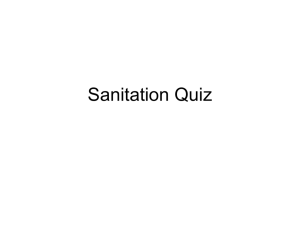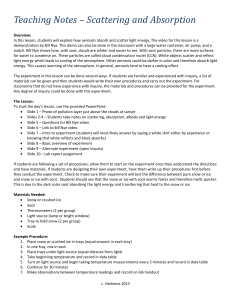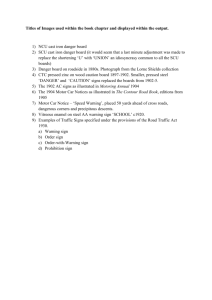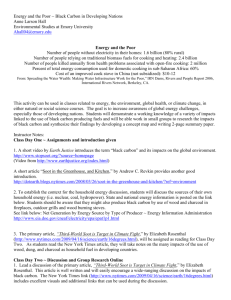4. What to do when the fire has been extinguished
advertisement
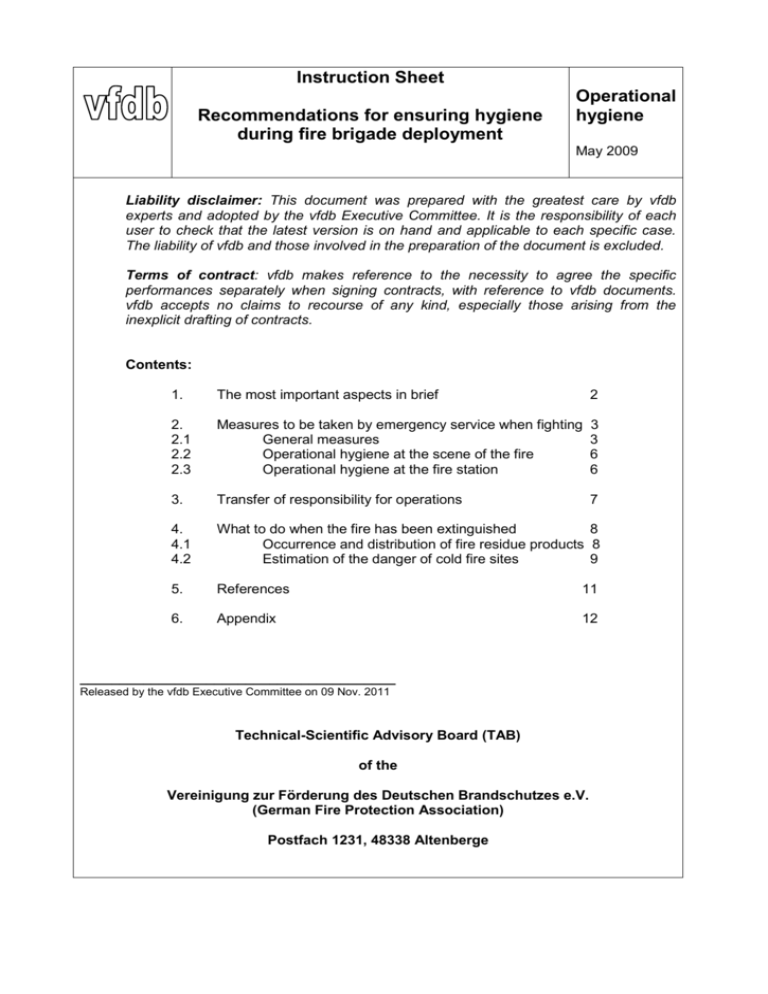
Instruction Sheet Recommendations for ensuring hygiene during fire brigade deployment Operational hygiene May 2009 Liability disclaimer: This document was prepared with the greatest care by vfdb experts and adopted by the vfdb Executive Committee. It is the responsibility of each user to check that the latest version is on hand and applicable to each specific case. The liability of vfdb and those involved in the preparation of the document is excluded. Terms of contract: vfdb makes reference to the necessity to agree the specific performances separately when signing contracts, with reference to vfdb documents. vfdb accepts no claims to recourse of any kind, especially those arising from the inexplicit drafting of contracts. Contents: 1. The most important aspects in brief 2 2. 2.1 2.2 2.3 Measures to be taken by emergency service when fighting General measures Operational hygiene at the scene of the fire Operational hygiene at the fire station 3 3 6 6 3. Transfer of responsibility for operations 7 4. 4.1 4.2 What to do when the fire has been extinguished 8 Occurrence and distribution of fire residue products 8 Estimation of the danger of cold fire sites 9 5. References 11 6. Appendix 12 ________________________________________ Released by the vfdb Executive Committee on 09 Nov. 2011 Technical-Scientific Advisory Board (TAB) of the Vereinigung zur Förderung des Deutschen Brandschutzes e.V. (German Fire Protection Association) Postfach 1231, 48338 Altenberge 1. The most important aspects in brief Smoke from a fire always contains health-damaging substances which can enter the body via the mouth, respiratory system, mucous tissue or skin. These toxins occur in particularly high concentrations as gases in hot smoke, which makes them easier to absorb. In cold smoke, toxins tend to be bonded to soot, condensation water or fly ash. Additional hazard sources can be raw, auxiliary, working or construction materials containing asbestos or synthetic mineral fibres as defined by technical regulation TRGS 521 which were caught in the blaze. Fire fighters can protect themselves to a great extent by observing the following rules of conduct: Respiratory protection must be worn as a fundamental principle while fighting a fire and for as long as the scene of the fire remains “warm” (1 to 2 hours after the fire has been extinguished (Fire Brigade Working Regulation FwDV 7). To the extent possible, emergency vehicles should be positioned outside the danger zone, i.e. beyond the range of the smoke gas. The penetration of smoke gas into the interiors of crew compartments must be avoided. Soot bonds toxins on its surface, thus making them less biologically available. Contaminated operational clothing does not therefore pose a direct hazard, but the intake of soot should be avoided at all costs. It must be ensured that operational clothing has been well aired before removing respiratory protection (outgassing from smoke). During operations, eating, drinking and smoking should only be permitted outside areas affected by soot and smoke gas once personnel have removed severely soiled clothing and thoroughly washed their faces and hands. After deployment, personal protective equipment (PPE) and other tools and implements should be subjected to preliminary cleaning at the scene of the fire. Severely soiled PPE and tools should be wrapped in dustproof packaging if they are to be transported in the crew compartment. It is not permitted to enter social or common rooms or to leave the fire station in clothing that is severely contaminated with soot. Personnel who were exposed to smoke and soot should shower and change their clothing after deployment. Contaminated equipment should be thoroughly cleaned before being returned to operation vehicles. Cold fire sites are categorised into danger zones GB 0 to GB 3 with regard to their contamination with pollutants in accordance with the German Insurance Association (GDV) guideline on the decontamination of fire damage (VdS 2357). The knowledge required for this purpose can be gained while fighting the fire. This categorisation leads to specific industrial safety measures for all activities within the scope of the decontamination of fire damage. If the fire service is involved in activities on the cold fire site, VdS 2357 should be adhered to with regard to the hazard assessment and to determine the protective measures for the personnel. The same applies to the further treatment (in particular cleaning and disposal) of PPE and other equipment used to fight the fire. 2. Measures to be taken by emergency services when fighting fires The assessment of the situation made by the director of operations must also take the following into account: Which pollutants are on hand (hazardous substances store, construction materials store)? Which pollutants can be released in the course of the fire (fire pattern, burning materials)? What effects do measures taken by the fire service have on the generation of pollutants (catchwords: extinguishing agent, allow to burn under control)? By which channels can pollutants escape from the scene of the fire? What pollutant situation can be expected at the scene of the fire? 2.1 General measures During extinguishing, the fire is taken through a temperature range in which increased pollutant generation occurs. This must be taken into account when assessing the situation. It must be weighed up in particular and on a case-to-case basis whether allowing the fire to continue to burn under controlled conditions may be better than extinguishing it. The composition of the smoke can be roughly calculated using standard fire brigade detection and measuring equipment. These rough estimates are sufficient for fire brigade operations as they are only intended as orientation values. They are only of practical value at mission control if they are required for the decision of the director of operations. Accordingly, they should not be used for press releases or recommendations to the general public either. Analysis equipment such as GC/MS is used within the nationwide Analytical Task Force (ATF). Experienced chemical experts are then be able to make definite hazard assessments for operational personnel on the basis of representative samples. This includes experience in metrology and knowledge of the composition of smoke. Apart from this, the determination of the lead substance is practicable for the decision of the director of operations. The criteria listed in VdS 2357 are not suitable for assessing the danger of the hot fire phase (fire fighting). The knowledge gained by the fire service with regard to the course of the fire and type and quantity of the burnt material can nevertheless provide valuable tips for the assessment of the cold fire site. An estimation of the hazard potential of the cooled fire site with categorisation to the danger zones GB 0 to GB 3 in line with GDV guideline VdS 2357 (see Section 6) is fundamentally not a task of the fire brigade. VdS 2357 is of use to fire services when they are working on cold fire sites (e.g. conducting safety and security measures or recovering tools and equipment, material assets or evidence). The number of persons deployed in the danger zone should be kept to the necessary minimum. Non-deployed personnel should be stationed outside the dispersion area of the soot and smoke gas. The exposure of operational vehicles and equipment to soot should be avoided wherever possible. Equipment that has been severely contaminated with soot should be precleaned at the place of use prior to removal. The swirling up of soot and ash should be avoided during follow-up extinguishing work and the ventilation of burnt-out areas. The risk of spreading the contamination is particularly big with flaky soot. It must be ensured that operational clothing has been well aired before removing respiratory protection (outgassing from smoke). When vehicles are deployed in the smoke zone, it must be checked whether they have been contaminated with acidic or basic smoke gases (pH value). Coatings can be removed by rinsing with water. Complete fire-fighting PPE (BBK1 and/0r BBK2 in line with vfdb regulation 08/05) and respiratory protection (observe FwDV7) must be worn when fighting fires. Compliance with Table 1 is required when working on cold fire sites. Table 1: Occupational Safety and Health Protection Measures by Danger Zone in accordance with VdS 2357 – PPE Matrix Fire Service Special Occupational Safety and Health Protection Measures by Danger Zone All information relates exclusively to cold fire sites. The regulations FwDV1, UVV Fire Service and FwDV7 apply to inspection and other work on sites that have not cooled down. When using repair chemicals and/or decontamination agents, the safety data sheets and manufacturers’ instructions contained therein apply additionally to PPE. It is possible to increase the amount of PPE, depending on the situation. 1 Minimum protective equipment in line with FwDV1, No. 2.1 )1 2 Body Protection Form 2 in line with FwDV 500, min. Cat. III, Type 5 or 6 3 Body Protection Form 2 in line with FwDV 500, min. Cat. III, Type 4 4 Splash protection apron 5 Respiratory protection, full mask, min. Class 3 particle filter (e.g. ABEK 2-P3) )2 )3 6 Chemical protection gloves in place of fire service protective gloves in line with FwDV 1, No 2.1 7 Foot protection S5d (rubber boots) in place of fire service protective footwear in line with FwDV 1, No. 2.1 8 Working clothing for work in the shelter (as listed under 1, above, if necessary) On-site inspections Fire service measures after fire-fighting Cleaning work (operational equipment) Inspection of cold fire sites Inspection of cold fire sites, incl. standing extinguishing water Activities without contact with extinguishing water or other liquids and without any particular risk of contamination (e.g. support work, creation of safe entrances or areas, safety repairs). Activities without contact with extinguishing water but with a risk of contamination through byproducts of the fire (e.g. work with rubble, demolition/dismantling of objects severely contaminated with soot, return of equipment severely soiled with soot). Activities with contact with extinguishing water (e.g. extinguishing water retention/ disposal, sealing measures, return of equipment from standing extinguishing water, removal of water contamination on construction sites). Rough cleaning on-site (brushing, spraying, wiping off etc.) Fine cleaning at the fire station (hand wiping method) Fine cleaning at the fire station (immersion bath method or high pressure cleaning) Danger Zone 0 Danger Zone 1 Danger Zone 2 1 1, (5) 1,5,6 1 1, (5), 7 1, 5 1, 5, 6, 7 2, 5, 6 2, 5 2, 5, 6, 7 3, 5, 7 3, 5, 6, 7 2, 5, (6) 2, 5, 6, 7 1 Danger Zone 3 Body protection in line with FwDV 500 by specific hazard. Decontamination measures in line with FwDV 500 and/or vfdb guideline 10/04 8 8, (5), 6 2, 5, 6 8, 4 8, 4, (5), 6, 7 3, 4, 5, 6, 7 ( ) consider and use as necessary )1 In the event of excessive dust, it is recommended that additional protective clothing EG Cat. I be worn on top of working clothing when performing these tasks )2 Ventilator-supported respiratory systems which do not rely on air circulation should be used when performing physically hard or moderately hard tasks )3 A suitable gas filter in compliance with BGR 190 should be used in the presence of gases or vapours Instruction Sheet “Recommendations for Operational Hygiene During Fire-fighting Operations” May 2009 2.2 Operational hygiene at the scene of the fire The scene of the fire must always be secured and cordoned off during fire brigade operations. After the fire has been extinguished, burnt-out rooms must be ventilated for at least 1 to 2 hours to remove volatile compounds (e.g. aromatics). Once the extinguishing work has been completed, soot should be roughly removed from PPE and other tools and equipment on-site. The criterion for successful pre-cleaning is the removal of all visible traces of soot. PPE parts with traces of soot should be kept outside the crew compartment or transported separately (plastic bag). The pre-cleaned equipment should also be transported separately and only loaded back onto the fire engine after fine cleaning has taken place. Fire engine cabs must be kept shut during operations and aired briefly when operations have ended. Personnel may only eat, drink or smoke during operations after removing severely soiled clothing and thoroughly washing their hands and faces. The criterion for adequate washing is that there are no visible traces of soot afterwards. Food and drink may only be consumed outside the fire area, beyond the range of the soot and smoke gas cloud. These principles also apply to subsequent on-site inspection and clean-up work and also for at least 1-2 hours after cross-ventilation of the site once the fire has been extinguished. When fighting fires, the prescribed personal protection equipment (PPE) including underclothing must be worn. In combination with a protective mask, the PPE should protect the skin completely from smoke gases and soot. 2.3 Operational hygiene at the fire station The equipment and vehicles used to fight fires must be thoroughly cleaned after every operation. Personnel must also clean themselves and their clothing. Boots must be thoroughly cleaned. Dirt and soot must be washed off (including the soles) using a soap and water solution if necessary. Boots should only be greased once all traces of soot and dirt have been removed, as the pollutants dissolve in grease. Severely soiled PPE (soot) should be exchanged after use. Cleaning with conventional cleaning agents is possible. The criterion for adequate cleaning is that there are no visible traces of soot after cleaning. Body areas contaminated with soot should be pre-cleaned locally with cold water and soap. This ensures that the pores stay closed so that the soot can be removed easily. Thorough body washing with hot water can only begin once all visible traces have been removed. Cleaning with organic solvents or substances containing grease should also be avoided as pollutants can dissolve in these products and penetrate into the skin. Fine cleaning can be regarded as successful if there are no visible traces of soot after washing with conventional body cleansing products. Private and operational clothing must be kept separate at the fire station. It is not permitted to leave the fire station in working clothing that is contaminated with soot. 3. Transfer of responsibility for operations The following chapter deals in detail with the various phases of a fire in order to clarify above all the phases in which the fire service has responsibility, which includes responsibility for the safety of persons inside the danger zone (area covered in smoke). The moment the fire brigade hands over the place of operations to the operator, owner or another authority, the site is considered a “cold fire site” in the view of the fire brigade. The director of operations decides on when to make the scene of the fire accessible to other persons or whether certain areas should be cordoned off. He/she hands over the site to the owner, operator or another authority and with it the responsibility for the restricted area. The fire service is not responsible for the evaluation of the categorisation of the “cold fire site” in line with the GDV guideline on the decontamination of fire damage (VdS 2357). Evidence of the properties of hazardous substances, which includes the identification and determination of by-products of the fire, is only of significance to the fire service if the results have an effect on operational tactics during fire-fighting operations; this is laid out and explained in detail in vfdb Guideline 10/05 “Detection of Harmful Concentrations in Fire Service Operations”. Once the fire has been extinguished, the victims are usually at a complete loss when they stand before a scene of utter destruction. All that remains in their house or apartment are soot and burnt-out furnishings, carpets, wallpaper, appliances, electric cables and perhaps even rubble. After a fire, the victims are usually uncertain as to what is the right thing to do. This has the result that the groups involved – fire services, police and other authorities (e.g. public health offices, construction authorities, national industrial safety authorities), insurance companies and renovation companies – are often faced with the following questions: What has to be done? Who can I contact? Who do I have to tell about the incident? What danger is posed by the residue of the fire and the pollution in my home? Can I enter my home again without risk? Which clean-up tasks can I do by myself without risk? Who is responsible for clean-up, disposal etc? To answer these questions, the instruction sheet “Handling of Cold Fire Sites” (VdS 2217 / vfbd 10/06) was prepared by the German Insurance Association (GDV) in cooperation with the German Fire Protection Association (vfdb) and jointly recommended for use. It contains a sample information sheet which can be completed by the emergency services and given to the victims after the fire has been extinguished and which insurance companies can also distribute to their customers. The information sheet can be individually structured by naming local points of contact and important regional reference addresses. The basic text should not be altered with regard to its content, however. To facilitate implementation, the instruction sheet VdS 2217, as well as the information sheet (VdS 2217a) to which the above-listed supplements should be added, are available as a download: www.vds.de Procedural Diagram Fire alarm Hot Fire Site Fire fighting Fire Brigade Final extinguishing Ventilation Transfer of responsibility for operations Damage report to insurance Cold fire site Owner, operator, authority Figure 1: Procedural diagram for the separation of the “hot” and “cold” fire site 4. What to do when the fire has been extinguished 4.1 Occurrence and distribution of fire residue products Hot fire phase The substances that form during the combustion process are released during the hot phase in the form of smoke. This means that all of the substances are mobile to begin with. The toxic and/or caustic gases and vapours that occur in high concentrations during this phase, such as carbon monoxide (CO), carbon dioxide (CO2), hydrogen chloride (HCl, hydrochloric acid when condensed), acrolein and hydrogen cyanide (HCN, prussic acid when condensed), constitute a potential hazard for the emergency services and fire-fighting crews. Cold fire site Once the fire has been put out and the burnt materials have cooled to the ambient temperature, above all hazardous organic substances – in particular soot particles – are adsorptively bonded directly to surfaces. This strong adsorptive bonding severely restricts their mobility. The evaluation of the mobility of fire residue products is an essential parameter of hazard assessment when clearing up fire damage. Note for emergency personnel: Because volatile toxins are still present in smoke even after the fire has been put out and for a period of approx. 2 hours after final extinguishing and cross-ventilation, masks and filters must be worn as a minimum requirement during the final extinguishing phase in the danger zone. Distribution of fire residue products The type and quantity of burnt material, the course of the fire and the extraction of the smoke gases are of decisive importance for the quantity of toxins formed and resultant contamination of the cold fire site with pollutants; these are the criteria which govern the burn pattern. The fewer indications there are for a fire with a lack of oxygen (smouldering fire), the less reason there is to suspect the occurrence of condensable fire residue products. Early destruction and thereby the opening of roofs and walls, a bright flame pattern during the blaze and a high fire load are indications of complete combustion at high temperatures and thereby less formation of pollutants. The assumed formation of pollutants does not yet constitute a direct hazard, however; there may also have been sufficient exposure to and bioavailability of these pollutants. Pollutants with low vapour pressure are usually so strongly adsorptively bonded to soot at fire scenes that the probability of intake through the skin can be regarded as slight in the event of possible contamination. In addition to the quantity, the mobility of the pollutants and thereby the possibility of their transfer to humans and the environment, is decisive for assessing the risk potential. It must nevertheless be taken into consideration that every cold fire site has to be regarded initially as a contaminated area, which means that a risk assessment has to be conducted before any activities are carried out. 4.2 Estimation of the danger of cold fire sites According to the criteria outlined in VdS 2357, the areas affected by fire and its residual products at the cold fire site can be categorised into danger zones GB 0 to GB 3. A danger zone is an area contaminated with pollutants as a result of a fire which can be separated from other areas. The substances which can pose a hazard on a cold fire site depend on the fire residue products and the extent and spatial distribution of contamination caused by fire damage and are based on the following parameters: Expansion of the contaminated (“fire-polluted”) area Type and quantity of burnt materials involved, in particular hazardous substances (= influence of burnt material) Fire conditions Fire pollution to be encountered at the scene of the fire Under consideration of the connections presented in the GDV guideline on the decontamination of fire damage (VdS 2357), the following danger zones can be defined for personnel deployed at the damage site: Danger Zone 0 (GB 0) Fires with a spatially tightly restricted expansion (approx. 1 m2) of the contaminated area, e.g. waste paper basket, candle bouquet or stove-top fires or fires with a larger expansion area but minimal fire contamination. Danger Zone 1 (GB 1) Fires with clearly visible fire contamination and larger expansion of the contaminated area than GB 0 in which standard household quantities of synthetic materials are burnt or with which no severe pollutant contamination is to be expected at the scene of the fire due to the fire conditions and pattern. Danger Zone 2 (GB 2) Fires with a larger expansion of the contaminated area and very severe fire contamination involving larger quantities of materials containing synthetic substances, in particular organochlorides and brominated substances, such as PVC (e.g. high-density cable routes, stored materials), and with which there is severe contamination with pollutants at the scene of the fire due to the fire pattern and progression. Smouldering fires with which the shell of the building is largely left intact and which result in the fire contamination of walls, ceilings and floors are typical GB 2 fires. Danger Zone 3 (GB 3) Fires with which larger quantities of biological work materials and/or hazardous substances or materials containing hazardous substances are to be expected in addition to the normal by-products of a fire. These can exist in the form of raw, auxiliary or working materials either in the building or on the premises. The possibility of asbestos and man-made mineral fibres (MMMF) should therefore be given special consideration. In addition to this, critical biological working substances can either be released directly or develop through subsequent processes. The measures outlined in Table 6 are recommended by the GDV on the basis of this classification in line with VdS 2357-05. Additional details can be taken from the charts in the appendix: Procedural diagram for the decontamination of fire damage with responsibilities (Figure A1) Guideline for the estimation of hazards (Figure A2) Note: Other hazards, such as the impairment of the building structure through the influence of corrosive by-products of the fire are not taken into account in the classification into danger zones. The risks that they pose should be determined and assessed separately. Table 2: Recommendations for the decontamination of fire damage and disposal of rubble (from the GDV guidelines for the decontamination of fire damage (VdS 2357-05) Danger Zone Involvement of Experts 0 Not required 1 Fundamentally no; recommended on caseby-case basis Cleaning / Decontamination Cleaning with no special measures Disposal Household refuse Cleaning/ Disposal concept decontamination with protective measures * 2 Urgently recommended Decontamination with Disposal concept special protective measures * 3 Required Decontamination with Disposal concept special protective measures * * Regulated in the guidelines for fire damage decontamination (VdS 2357, 2007-04 (05)) The involvement of a fire damage decontamination expert is urgently recommended for Danger Zone 2 and required for Danger Zone 3. This expert then also decides whether analytical tests are required to assess the damage [proportions of chlorinated aromatic compounds (predioxins), aromatics, halogen compounds, pesticides]. Tests can also be necessary in areas which do not appear to be affected, within the scope of workplace approval after responsibility for the site has been passed to the office for industrial safety or the owner. These are not the responsibility of the fire service, however. 5. References Handbuch der gefährlichen Güter, G. Hommel, 1986, Springer Verlag, Berlin. Sicherheitstechnische Kennzahlen brennbarer Gase und Dämpfe, K. Nabert, G. Schön, 1963, Deutscher Eichverlag, Braunschweig. Giftliste, L. Roth, M. Daunderer, 1987, ecomed Verlagsgesellschaft, Landsberg. Chemiebrände, L. Roth, U. Weller, 1990, ecomed Verlagsgesellschaft, Landsberg. GESTIS-Stoffdatenbank - Gefahrstoffinformationssystem der gewerblichen Berufsgenossenschaften; Institut für Arbeitsschutz (BGIA) der Deutschen gesetzlichen Unfallversicherung; im Internet abrufbar unter: http://www.dguv.de/bgia/de/gestis/stoffdb. MEMPLEX Datenbank, keudel av Technik GmbH Richtlinien zur Brandschadensanierung (VdS 2357), 5. Auflage, 2007, Gesamtverband der Deutschen Versicherungswirtschaft e.V. (GDV), Berlin. Umgang mit kalten Brandstellen - Muster für ein Informationsblatt der Feuerwehren an brandgeschädigte Haushalte (VdS 2217), 1. Auflage, 1998, inhaltsgleich mit vfdbRichtlinie 10/06), Gesamtverband der Deutschen Versicherungswirtschaft e.V. (GDV), Berlin. Leitlinien zum Umgang mit kontaminiertem Löschwasser (VdS 2557), in Vorbereitung, Gesamtverband der Deutschen Versicherungswirtschaft e.V. (GDV), Berlin. vfdb-Richtlinie 10/03 Schadstoffe bei Bränden (2009) 6. Appendix Figure A1: Procedural diagram for the decontamination of fire damage with responsibilities (in accordance with the GDV guidelines for the decontamination of fire damage (VdS 235705)) Responsibilities Conducted by ... Procedural diagram Fire incident Damage report to insurance Victim / insurance holder Securing of the scene of the damage Victim / insurance holder Initial on-site inspection Claims representative / insurance holder / third party representative Protective measures in line with Chap. 5.1 and 5.2 Division of the scene of the damage into danger and work zones (Chap. 3.5 and 3.6) Claims representative / insurance holder / third party representative Danger Zones GB 0 Commissioning of an expert not required GB 1 Commissioning of an expert recommended case by case GB 2 GB 3 Commissioning of an expert urgently recommended Immediate Measures Protective measures in line with Chap. 5.1 and 5.2 Protective measures in line with Chap. 5.4 Household refuse Decontamination and Disposal Concept incl. hazard assessment and work and safety plan GB 1 GB 2 GB 3 Chap. 5.5 Chap 5.6 Chap 5.7 Commissioning of an expert required Specialised decontamination company in line with BGR 128 Specialised expert/ decontamination company in line with BGR 128 Remedying of damage Specialised decontamination company in line with BGR 128 Acceptance and control of results where necessary Victim / insurance holder Disposal of fire and decontamination residue in line with disposal concept Disposal company Figure A2: Guideline for the estimation of hazards (in accordance with the GDV guidelines for the decontamination of fire damage (VdS 2357-05)) Fires in Residential buildings Public facilities, offices and other administration buildings Stores, commercial and industrial production sites Spatial expansion of contaminated areas slight expanded Burnt materials and other substances involved Small quantities of synthetic materials Large quantities of synthetic materials Hazardous substances Biological working materials Type of fire Minimal contamination Full blaze with hardly any smouldering Distinctly smouldering fire Fire contamination Fire contamination Clearly visible contamination Very severe contamination GB 0 GB 1 GB 2 GB 3 Expert not required Expert recommended on a case-by-case basis Expert urgently recommended Expert required Explanations of the assessment criteria in accordance with VdS 2357 (see Figure A2) Spatial expansion of the contaminated area Slight: Spatially limited fire contamination, e.g. after a waste paper basket, candle bouquet or stovetop fire. Expanded: Fire contaminated area extends over commercial, production and storage warehouses or several rooms/floors of residential or office buildings. Burnt materials and other substances involved Materials containing synthetic substances can result in the increased release of pollutants in the event of fire. Special attention should be paid to materials containing synthetic substances such as PVC, PU, PS or melamine and phenolic resin etc. These can be contained in insulation materials, floor coverings, packagings, electrical and electronic devices, window frames, false ceilings and chipboard, for example. “Small quantities of materials containing synthetic substances” can be assumed if the substances mentioned above are only affected by a fire in the quantities that are customary in a normal household. The same applies to office and administration areas with standard office fittings. “Large quantities of materials containing synthetic substances” can be assumed if production and storage areas, higher-density cable routes, computer centres, control rooms, large insulated roof areas and the like are affected by the fire. “Other substances involved” refers to hazardous substances and biological working materials which: a) were already on site as raw, auxiliary, working or construction materials (including asbestos and synthetic mineral fibres) before the fire broke out or were released as a result of the fire or which b) only occurred as an indirect result of the fire, e.g. bacteria or dangerous reaction products caused by the breakdown of systems. Type of fire Full blaze with hardly any smouldering: - Open fire with bright flame pattern and smoke extraction through openings in the building - Unrestricted distribution of fire by-products Distinctly smouldering fire: Fire situations involving a lack of oxygen, such as - Sealed off rooms - Minimal extraction to the open air - Pressure build-up in interiors Fire contamination Minimal contamination: - Few soot particles to be found (not covering the entire area) - Thin film of smoke condensate which can hardly be recognised on tarnished surfaces but which appears as a dark stain when wiped off with a white cloth. Clearly visible contamination - Covering of soot particles over the entire surface - Film of smoke condensate over the entire surface with clearly visible discoloration of the soiled surfaces Very severe contamination - Thick coating of soot particles over the entire surface - Thick film of smoke condensate with intensive blackening of surfaces
